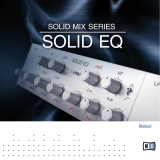
10
Depending on the host application implementation, the
delay compensation feature may not provide automatic
compensation when Duende plug-ins are inserted on
sends, groups, or buses. In this situation, the solution is
to manually compensate for the plug-ins.
These explanations of delay compensation apply primarily
to playback only.
Compensating for latency in Pro Tools LE and M-Powered
Because Pro Tools LE and M-Powered do not feature PDC
it must be done manually when plug-ins are used. Due to
the Hybrid Core Processing technology of Duende V3, a
small latency is introduced which will delay any audio
track, aux input, master fader or instrument track by a
specific amount. Tracks that use no Duende plug-ins or
fewer than the track with the most Duende plug-ins will
need to be delayed so that all tracks are in time. Because
this latency is reported by Pro Tools it is easily
compensated for.
The track with the most Duende plug-ins will introduce
the most latency, those with 1 or 2 plug-ins will introduce
less and those with no Duende plug-ins will introduce no
latency
(providing other plug-ins that introduce latency
are not used)
.
To find out the latency introduced on a particular track by
Duende plug-ins, go to the channel in the mixer and
‘Command/Ctrl+Click’ twice in the green text below the
fader
(normally showing vol)
. The value shown
(dly)
is the
latency introduced on that track in samples.
Now load the ‘Digidesign Time Adjuster Long’ plug-in on,
for example, a track with no Duende plug-ins. Double click
on the delay box and type in the latency value of the track
that has the most Duende plug-ins. The track with the
most Duende plug-ins and the track with none will now be
perfectly in sync on playback. Any tracks that have a
smaller latency than the maximum must also be delayed
but by a smaller amount
(ie. tracks with 1 Duende plug-
in where the maximum has 3)
.
The delay value for these will be maximum latency minus
the latency reported by that track. Pro Tools HD users
have the luxury of being able to use Automatic Delay
Compensation, as opposed to the manual method
required in Pro Tools LE and M-Powered.























